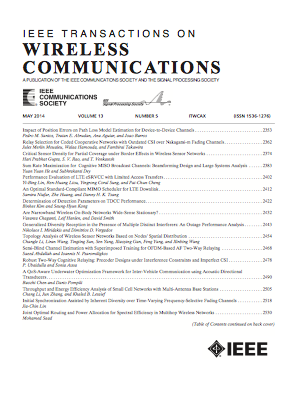多端口匹配网络的深度展开波束形成和功率控制设计
IF 10.7
1区 计算机科学
Q1 ENGINEERING, ELECTRICAL & ELECTRONIC
引用次数: 0
摘要
第六代(6G)关键技术,如超大规模多输入多输出(MIMO),使天线和无线传播环境之间的复杂交互成为可能。因此,有必要开发包含天线和无线传播信道的联合模型。为了实现这一点,我们利用多端口通信理论,该理论考虑了源,传输介质和负载之间的阻抗匹配,以促进有效的功率传输。具体来说,我们首先研究了插入损耗、互耦和其他因素对多端口匹配网络性能的影响。接下来,为了进一步提高系统性能,我们分别探讨了多端口匹配网络的两种重要的深度展开设计:波束形成和功率控制。对于混合波束形成,我们开发了一个深度展开框架,即基于展开投影梯度下降的投影梯度下降(PGD)-Net。在功率控制方面,我们设计了一种深度展开网络,即图神经网络(GNN)辅助交替优化(AO)网络,该网络在优化功率分配时考虑了不同端口之间的相互作用。数值结果验证了在动态超表面天线(DMA)性能分析中考虑插入损耗的必要性。此外,本文提出的基于PGD-Net的混合波束形成方法与传统的基于模型的算法接近,且复杂度很低。此外,与传统的加权最小均方误差(WMMSE)方法相比,我们提出的功率控制方案具有更快的运行时间。本文章由计算机程序翻译,如有差异,请以英文原文为准。
Deep Unfolding Beamforming and Power Control Designs for Multi-Port Matching Networks
The key technologies of sixth generation (6G), such as ultra-massive multiple-input multiple-output (MIMO), enable intricate interactions between antennas and wireless propagation environments. As a result, it becomes necessary to develop joint models that encompass both antennas and wireless propagation channels. To achieve this, we utilize the multi-port communication theory, which considers impedance matching among the source, transmission medium, and load to facilitate efficient power transfer. Specifically, we first investigate the impact of insertion loss, mutual coupling, and other factors on the performance of multi-port matching networks. Next, to further improve system performance, we explore two important deep unfolding designs for the multi-port matching networks: beamforming and power control, respectively. For the hybrid beamforming, we develop a deep unfolding framework, i.e., projected gradient descent (PGD)-Net based on unfolding projected gradient descent. For the power control, we design a deep unfolding network, graph neural network (GNN) aided alternating optimization (AO)-Net, which considers the interaction between different ports in optimizing power allocation. Numerical results verify the necessity of considering insertion loss in the dynamic metasurface antenna (DMA) performance analysis. Besides, the proposed PGD-Net based hybrid beamforming approaches approximate the conventional model-based algorithm with very low complexity. Moreover, our proposed power control scheme has a fast run time compared to the traditional weighted minimum mean squared error (WMMSE) method.
求助全文
通过发布文献求助,成功后即可免费获取论文全文。
去求助
来源期刊
CiteScore
18.60
自引率
10.60%
发文量
708
审稿时长
5.6 months
期刊介绍:
The IEEE Transactions on Wireless Communications is a prestigious publication that showcases cutting-edge advancements in wireless communications. It welcomes both theoretical and practical contributions in various areas. The scope of the Transactions encompasses a wide range of topics, including modulation and coding, detection and estimation, propagation and channel characterization, and diversity techniques. The journal also emphasizes the physical and link layer communication aspects of network architectures and protocols.
The journal is open to papers on specific topics or non-traditional topics related to specific application areas. This includes simulation tools and methodologies, orthogonal frequency division multiplexing, MIMO systems, and wireless over optical technologies.
Overall, the IEEE Transactions on Wireless Communications serves as a platform for high-quality manuscripts that push the boundaries of wireless communications and contribute to advancements in the field.

 求助内容:
求助内容: 应助结果提醒方式:
应助结果提醒方式:


